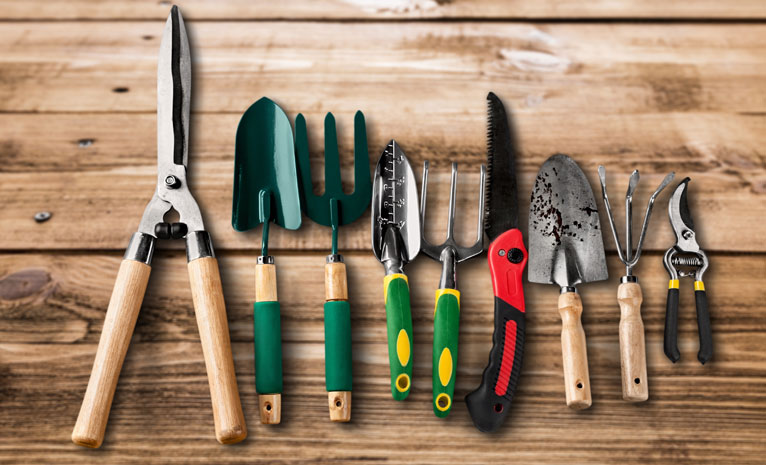Gardening can be a relaxing hobby which allows a person to get back to his roots, back to nature and bring some balance and peace into his life.
While working with your bear hands can be enjoyable in the beginning, thinking about skin care and work efficiency leads us to two major solutions – hand or power tools.
In this text we’ll be discussing hand tools and their uses in the garden, what they are used for and how they are operated properly.
Also we’ll be discussing the benefits of working with hand tools rather than electrical or gasoline powered ones, not only for nature, but your peace of mind as well.
The benefits of gardening with hand tools instead of electrical ones
While modern technology brings a lot of utility and convenience to our doorstep, there is something could be said about the cyclical nature of repetitive motion and work.
There’s little to no doubt that electrical and engine gardening tools are far more efficient, which is why they see such wide use with professionals.
So why use gardening hand tools then? Mostly because it’s relaxing and it allows you to pay far more attention and keep attention to detail than with power tools – they are quiet and require some concentration to you, allowing you to interface with nature in a controlled and quite serene way.
What sort of hand tools are out there
They can be summarized in tree major categories – cutting, digging and soil preparation with the most notable choices being hand hoe variations and tilling tools.
Tilling and soil preparation
A small scale garden, regardless if it’s going to be producing flowers, or fruiting plants like bell peppers, cucumbers, tomatoes or mint, requires attention and soil maintenance.
One way of achieving a nicely aerated top soil is using a hand tiller, which can be a hand held tiller or a hand rototiller which has some mechanical properties.
These tillers have a simple mechanism which requires gentle pressure and a pushing and pulling motion. They are best used after initial top soil maintenance with a hoe which breaks up any major chunks of soil – the most efficient use of these tools are when the ground is still retaining some moisture, but no more than 30%.
The hand cultivator, hand rake and hand trowel are small hand tools best used in small or confined spaces.
The cultivator and hand rake different in the size and frequency of their “teeth” and best used for the aeration of top soils as to allow for the circulation of air and other minerals and nutrients to permeate deeper into the soil.
The hand cultivator has a stronger bond between the different teeth which allows it to operate and work with heavier soil compositions.
The hand rake is used to create sham channels in the soil which can be used for planting seeds or for removing fine grass clippings from the edges of a lawn.
The hand trowel is used for digging and creating small holes or for finishing touches on bigger ones where shovels start lacking in mobility and efficiency.
Cutting and lawn maintenance gardening tools
The sign of a well kept garden is a beautifully manicured lawn which can be achieved both with hand and power tools.
After most of the visible work is done, with the use of a lawn mower, there are finer details which need to be deal with, details which only hand and small tools can deal with.
A good example is the work which can be done with a small hand weeder tool – it’s simplistic in design, small enough that it will fit on any tool belt, and is irreplaceable because it allows you to remove weeds from a distance.
The big difference between hand weeder and a weed whacker is that the hand tool does not spread the seeds of the weeds, but rather acts as a 3rd arm for the gardener.
In cases where there are long and high standing grasses which are thick, but are too few to warrant the use of a weed whacker, you can always use a hand sickle.
The sickle used to be the main way of harvesting wheat cultures and is a major tool in Asian countries which rely on rice cultivation.
The hand pruners are a multi tool which is basically a really sharp garden scissor suitable for the removal and trimming of small branches. The strength require to operate it depends on the species of tree or plan and the sharpness of its cutting edges – keep them sharp to make quick work of any unwanted growths.
Grass trimming tools
A well manicured lawn needs its edges trimmed on a regular basis. If left unchecked, nature will eventually take back the territory we cultivated and this can be seen best at the edges of a lawn where it roots and grass tops start “spilling” onto sidewalks.
A great trimming tool to use for removing and edging your lawn are the hand edger and long handled grass shears which have a stop guide providing precision removal of grass. They are guided by the solid sides of a sidewalk and will remove any grass which is spilling over to concrete structures, leaving a cleanly cut and well maintained lawn.
Another good choice for grass trimming is the hand held grass trimmers which are a battery powered small variation of grass sheers. They are ideal for trimming bushes and grass between corners, they are perfect for long stretch use and come in different power variations, some models even posses a lilt function which allows you to remove grass around lamp posts and walls.
We hope this short has been informational and helpful for you, if you want to check our previous installment, you can check our article on the Best Gardening Tools.





